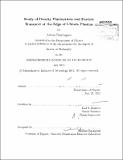| dc.contributor.advisor | Earl S. Marmar. | en_US |
| dc.contributor.author | Dominguez, Arturo, Ph. D. Massachusetts Institute of Technology | en_US |
| dc.contributor.other | Massachusetts Institute of Technology. Department of Physics. | en_US |
| dc.date.accessioned | 2013-06-17T19:51:27Z | |
| dc.date.available | 2013-06-17T19:51:27Z | |
| dc.date.copyright | 2012 | en_US |
| dc.date.issued | 2012 | en_US |
| dc.identifier.uri | http://hdl.handle.net/1721.1/79261 | |
| dc.description | Thesis (Ph. D.)--Massachusetts Institute of Technology, Dept. of Physics, September 2012. | en_US |
| dc.description | Cataloged from PDF version of thesis. | en_US |
| dc.description | Includes bibliographical references (p. 201-208). | en_US |
| dc.description.abstract | The wide range of plasma parameters available on Alcator C-Mod has led to the accessibility of many regimes of operation. Since its commissioning, C-Mod has accessed the Linear ohmic confinement, Saturated ohmic confinement, L-Mode and ELM-free, ELMy and Enhanced D[alpha] H-Mode regimes. Recently, another novel regime, the IMode, has been identified[1][2][3][4]. I-modes feature the presence of steep H-Mode-like electron and ion temperature gradients at the edge of the plasma with L-Mode-like density profiles. The I-Mode, in contrast to the Hl-mode, shows very weak degradation of energy confinement with increased input power, and routinely reaches H98 > 1 while operating at low edge collisionalities ... making it a good candidate for reactor relevant tokamaks. Also relevant for reactors, this regime can be sustained in steady state for more than -15 energy confinement times without the need for ELMs to regulate particle and impurity confinement. Changes in edge density, temperature and magnetic field fluctuations accompany the L-mode to I-mode transition, with reduction of fluctuations in the 50-150kHz range as well as the appearance of a Weakly Coherent Mode (WCM) in the 200-300kHz range, analogous to the Quasi-Coherent Mode (QCM) characteristic of the Enhanced D[alpha] H-mode. Previous work[4] has established a connection between the midrange fluctuation suppression and reduction in the effective thermal diffusivity, Xye, in the pedestal region. The mechanism in I-mode for maintaining sufficient particle transport to avoid impurity accumulation and instabilities has been unclear. The O-mode reflectometry system has been extensively used for the characterization and detection of the I-mode and the WCM, in part, enhanced by upgrades to the system which enabled the baseband detection of density fluctuations at an array of cutoff locations at the edge of the plasma[5] [6] [7]. Using a novel model, the autopower signals of reflectometry channels detecting the density fluctuations have been decomposed into a broadband component and a WCM component. The latter is then used to estimate the intensity of the WCM. In parallel, the particle transport across the LCFS in I-mode plasmas has been estimated using a volume integrated particle transport model, where ionization source measurements are acquired using D[alpha] profiles measured near the outboard midplane. This model takes into account the anisotropic ionization source density around the periphery of the plasma by introducing an asymmetry factor, [sigma], which is then estimated using a study of I-Mode to H-Mode transitions. The results imply that measurements at the outboard midplane overestimate the surface-averaged influx. Finally, a comparison has been made between the particle flux across the LCFS of the I-mode and the intensity of the WCM, which shows a generally positive correlation between the two. This is supporting evidence that the WCM is, in fact, responsible for maintaining particle and impurity transport across the edge of the I-mode energy transport barrier. | en_US |
| dc.description.statementofresponsibility | by Arturo Dominguez. | en_US |
| dc.format.extent | 208 p. | en_US |
| dc.language.iso | eng | en_US |
| dc.publisher | Massachusetts Institute of Technology | en_US |
| dc.rights | M.I.T. theses are protected by
copyright. They may be viewed from this source for any purpose, but
reproduction or distribution in any format is prohibited without written
permission. See provided URL for inquiries about permission. | en_US |
| dc.rights.uri | http://dspace.mit.edu/handle/1721.1/7582 | en_US |
| dc.subject | Physics. | en_US |
| dc.title | Study of density fluctuations and particle transport at the edge of I-mode plasmas | en_US |
| dc.type | Thesis | en_US |
| dc.description.degree | Ph.D. | en_US |
| dc.contributor.department | Massachusetts Institute of Technology. Department of Physics | |
| dc.identifier.oclc | 846591202 | en_US |
